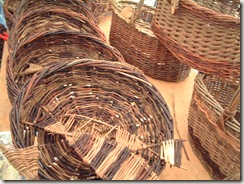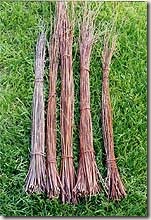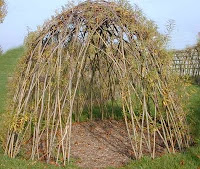Sunday 29 November 2009
Woodland Animals and Willow Cutting
Tuesday 24 November 2009
Living Willow Maze, Whale Hill Primary School
We have one more day at Whale Hill in December when we will plant some different willow varieties in the maze and generally tidy up. Mazes are probably the most physically challenging living willow sculptures to make as there are so many planting holes to make even with the children helping.
Sunday 22 November 2009
Willow Badger
despite suffering from the flu we have had to continue making the woodland creatures for the Woodland Trust to be installed at their new Heartwood in Hertfordshire. Steve has been working on an owl and a squirrel. Its very hard to weave a good likeness. Simone has been working on Broc the Badger and its looking very good. We are having to work in our conservatory and the rain is pounding on the glass but we are happy listening to Waulk Electric on our minidisc player.
Friday 20 November 2009
Whale Hill Primary School, Willow Maze
 We have been working at Whale Hill, near Middlesborough this week. We avoided the rain and floods of Cumbria and stayed in Saltburn-by-the-sea. The weather was very windy and overcast but not the torrential rain of Cumbria. We worked with years 5 & 6 to start marking out the maze. Despite suffering from flu we struggled on all week and ewven visited the seaside at Redcar. We will have to spend the weekend recovering in bed drinking honey and lemon and sucking throat sweets.
We have been working at Whale Hill, near Middlesborough this week. We avoided the rain and floods of Cumbria and stayed in Saltburn-by-the-sea. The weather was very windy and overcast but not the torrential rain of Cumbria. We worked with years 5 & 6 to start marking out the maze. Despite suffering from flu we struggled on all week and ewven visited the seaside at Redcar. We will have to spend the weekend recovering in bed drinking honey and lemon and sucking throat sweets.
Tuesday 17 November 2009
WILLOWPOOL BASKETS

Here is an old price list that I found in an old pc that we used to use
WILLOW POOL BASKETS, STEVE FULLER BA HONS, 9 WESTON HOUSES, DOVE NEST LANE, ENDMOOR, NR KENDAL, CUMBRIA LA8 0HA
TEL. 015395-67056
Willow Pool Baskets began as 'Hedgerow Baskets' in 1979. Steve Fuller was initially taught by John Rome, a Cumbrian farmer who was a noted basketmaker who grew his own willow and specialised in fishing creels. Willow basketry has a strong tradition in the border regions of Cumbria and Dumfriesshire. John Rome was taught by his uncle, and local farms used to be supplied with 'swill baskets' [frame baskets for harvesting potatoes, feeding livestock etc] by itinerant craftsmen using willow and hazel from local woods and riverbanks. I aim to continue the tradition of sturdy, durable country baskets for a variety of uses and also will be offering some baskets made of recycled contemporary material.I am also interested in using living willow for environmental sculpture such as tunnels and mazes, and can advise or assist on living history/countryside/environmental projects. I welcome enquiries for repair and restoration/reconstruction work. I can also advise on willow cultivation and obtain cuttings for planting.
Demonstrations, workshops, talks etc can be arranged for schools, museums, art centres and countryside venues. Some of my past events have been at Tullie House [Carlisle], Durham Dales Centre [Stanhope], Bluecoat Display Centre [Liverpool], Carlisle Castle, Primervera (Cambridge),Althorp [Northhampton], Bede Museum [Jarrow], Woodland Event [East Cumbria Countryside Project], Tweeddale Museum [Peebles], Seatoller Barn [Keswick] and the Great North Forest (Tyne and Wear/Durham).
Traditional Log Baskets - 15" base, 15" high ..........£35.00
Low Log Baskets - 15" base, 12" high..........£30.00
Slender Log Baskets - 11" base, 15" high..........£30.00
Oval Washing Baskets - 12" by 18" base, 9" high..........£32.00
Round Linen Baskets - 14" base, 24" high (with lid) ..........£44.00
Willow Cradle - 30" by 16" base, 14" at head..........£50.00
Oblong Shopper - small, large..........£19.50, £22.00
Round Shopper - small, medium..........£15.00, £18.00
Oval Shopper - small, medium, large..........£15.00, £17.00, £20.00
Short base Oval Shopper - one size..........£17.00
Flower Basket (trug shape)..........£22.00
Apple Picker - 9" base, 5" high..........£22.00
Blackberry Basket - 8" by 5" base, 5" high..........£12.00
Egg Basket - 11" base, 4" high..........£17.00
* Please note that Carriage is extra.
LIVING WILLOW MAZE
We are loading the van with willow for the Living Willow Maze at Eston, Middlesborough. The construction begin tomorrow morning with groups of year 6 children. They will be doing the initial digging to form the shape of the maze. Its nice an sunny here in Kendal at the moment after much torrential rain so now is the time to get the will loaded on the roof.
Our good news is that Simone passed her ‘Life In The UK’ test that she had to take in order to get a UK passport. This is despite having lived here for nearly 30 years, owning a house here, having 2 children educated to degree level here, paying taxes here and running a business here. Now we have to find nearly £1000 to actually get the passport.
Thursday 12 November 2009
Grange Primary School and Surestart, Bootle
We are working at Grange Primary for 3 days this week. We have built a living willow tunnel in the Surestart Garden and are building a dome and a tunnel in the Reception garden.
Garston Primary School, Liverpool

We worked with the Reception children at Garston on Monday. We built a living willow dome in the nursery area. The children were lovely, very chatty and interested in the construction of their dome. Simone made everyone a willow star to take home and a living willow heart to grow in the classroom.
Monday 9 November 2009
New Living Willow Season
Today we were at Whale Hill Primary School, Eston nr Middlesborough. We had an introductory day with the children prior to making a large living willow maze. We took part in a special assembly to tell the children all about willow and how they can use their completed maze for both study and play. In the afternoon we marked out the maze in readiness for the children to do their digging and planting tasks next week.
Simone has decided to finally take the plunge and become a British citizen after nearly 30 years of being an American in Cumbria. This is much more complicated than we had thought and Simone has to take a 'Life in the UK' test! I can't answer many of the questions on the 'helpful' booklet supplied by HMSO. Many of the questions seem to be quite obscure. I was hoping that they would be along the lines of 'Why is Big Brother so Boring?, 'who is Dr Who?' etc.
Friday 6 November 2009
SCHOOL ENTERPRISE PROJECT
Thursday 5 November 2009
Tuesday 3 November 2009
Old Article About Steve
by Judith M. Fertig
According to his surname, Steve Fuller should be carrying on his family's ancestral trade of cloth fulling. But several years ago, when he and his wife moved to Longtown near Carlisle in the Lake District, he turned to dairying to make a living. Soon afterwards, Fuller took a locally offered basketmaking course and turned from what ancestry and necessity had previously demanded. He liked making baskets and decided to become a craftsman.
An old farmer, John Rome, taught the basketry course and was pleased that Fuller took such an interest. Although willow basket making is a traditional craft in the Longtown area, few young people are willing to learn it and carry it on. When the dairy farm where he was working was sold, Fuller was left without a full-time job. He decided to turn his hobby into a business, and Hedgerow Baskets was born. After several years of making and selling baskets from his cottage, Fuller began taking part in crafts fairs in the Lake District and Scotland. A craft store in Caithness, Scotland bought his baskets and it, in turn, made a sale to Queen Elizabeth, The Queen Mother. Now, Fuller says jokingly, he dreams of seeing the Royal crest and 'by appointment to H.M. Queen Elizabeth The Queen Mother' emblazoned above his shop.
Royalty aside, Steve Fuller's baskets are special. He starts with good quality English willow that is grown and harvested for him in Somerset. 'I can't do the growing and the harvesting and the basket-making. It's all too labour-intensive,' he claims. He does, however, use some of the willow from his garden. The willow comes in three natural colours. Brown willow still has the natural bark. White willow has had the bark peeled off. And the buff colour results from the willow being boiled with the bark on; the tannin in the bark dyes the willow a soft brown. With only a knife and a pair of cutters, Fuller begins a basket by making the base first. He weaves the different strands of willow into a traditional design, and gradually he builds up the sides, sometimes adding a decorative border of three colours near the rim. Lastly, he weaves and attaches the handle. At least two hours are spent on every basket.
At a crafts fair in Scotland a few years ago, Fuller met Duncan Williamson, a 'traveller' or gypsy. A gifted storyteller who has had several books published by Penguin, Williamson nevertheless turned to basketry to 'fill in' the slack periods when income and outgo were not so well matched. Williamson taught Fuller the gypsy way of making baskets with a bare minimum of tools, using only hands and thumbs to split and cut. 'I'm very open to different ways of doing my craft,' says Fuller, 'but they must be traditional ways.'
Tradition luckily supplies a wide range of basket styles. Round shopping baskets, garden trugs, lag and washing baskets, baby cradles, apple pickers and oval baskets are all in Fuller's repertoire. His three most popular styles are the oval shopping, the garden trug and the log basket. But even though two people may buy the same style basket, each will have a different and unique piece. 'I seldom do a basket exactly the same way twice,' explains Fuller. 'I like to vary the style and use different types of willow and colours.'
The countryside around him is also an inspiration. 'I take my dog for walks into Scotland. The border is not far from my cottage and I love to get out and walk,' Fuller says. The muted colours of the hills and fellsides, changing in sunlight and cloud, give him ideas for new textures and weavings of colour. This area of Cumbria is the Debatable Land, once hotly contested between England and Scotland. Border reivers once plagued the region before Wordsworth and Coleridge had admired their first daffodils. But some things last. Steve Fuller's baskets are a part of the Lake District that you can keep for many years, and then pass on to the next generation.
Royalty aside, Steve Fuller’s baskets are special. He starts with good quality English willow that is grown and harvested for him in Somerset. ‘I can’t do the growing and the harvesting and the basket-making. It’s all too labour-intensive,’ he claims.
He does, however, use some of the willow from his garden. The willow comes in three natural colours. Brown willow still has the natural bark. White willow has had the bark peeled off. And the buff colour results from the willow being boiled with the bark on; the tannin in the bark dyes the willow a soft brown. With only a knife and a pair of cutters, Fuller begins a basket by making the base first. He weaves the different strands of willow into a traditional design, and gradually he builds up the sides, sometimes adding a decorative border of three colours near the rim. Lastly, he weaves and attaches the handle. At least two hours are spent on every basket.
At a crafts fair in Scotland a few years ago, Fuller met Duncan Williamson, a ‘traveller’ or gypsy. A gifted storyteller who has had several books published by Penguin, Williamson nevertheless turned to basketry to ‘fill in’ the slack periods when income and outgo were not so well matched. Williamson taught Fuller the gypsy way of making baskets with a bare minimum of tools, using only hands and thumbs to split and cut. ‘I’m very open to different ways of doing my craft,’ says Fuller, ‘but they must be traditional ways.’
Tradition luckily supplies a wide range of basket styles. Round shopping baskets, garden trugs, lag and washing baskets, baby cradles, apple pickers and oval baskets are all in Fuller’s repertoire. His three most popular styles are the oval shopping, the garden trug and the log basket. But even though two people may buy the same style basket, each will have a different and unique piece. ‘I seldom do a basket exactly the same way twice,’ explains Fuller. ‘I like to vary the style and use different types of willow and colours.’
The countryside around him is also an inspiration. ‘I take my dog for walks into Scotland. The border is not far from my cottage and I love to get out and walk,’ Fuller says. The muted colours of the hills and fellsides, changing in sunlight and cloud, give him ideas for new textures and weavings of colour. This area of Cumbria is the Debatable Land, once hotly contested between England and Scotland. Border reivers once plagued the region before Wordsworth and Coleridge had admired their first daffodils. But some things last. Steve Fuller’s baskets are a part of the Lake District that you can keep for many years, and then pass on to the next generation.
British Heritage Magazine, USA December/January1988/89

